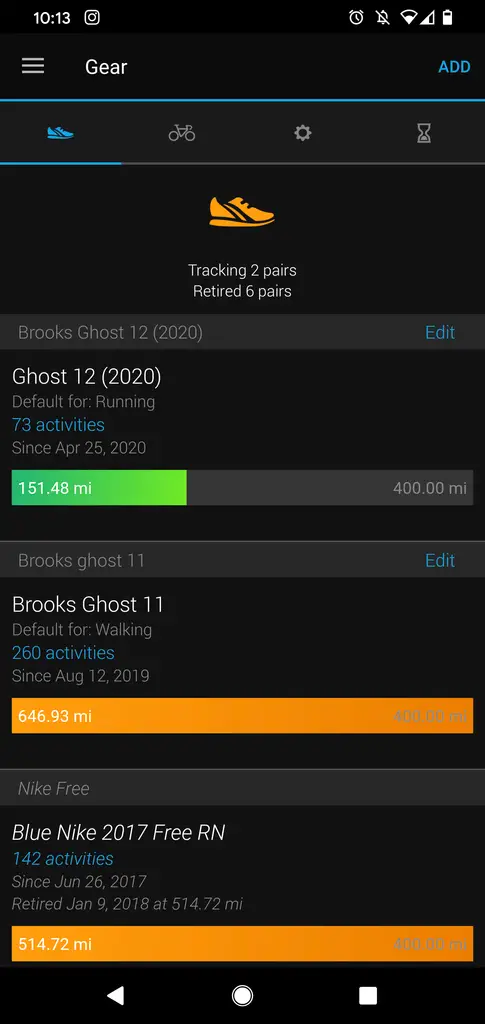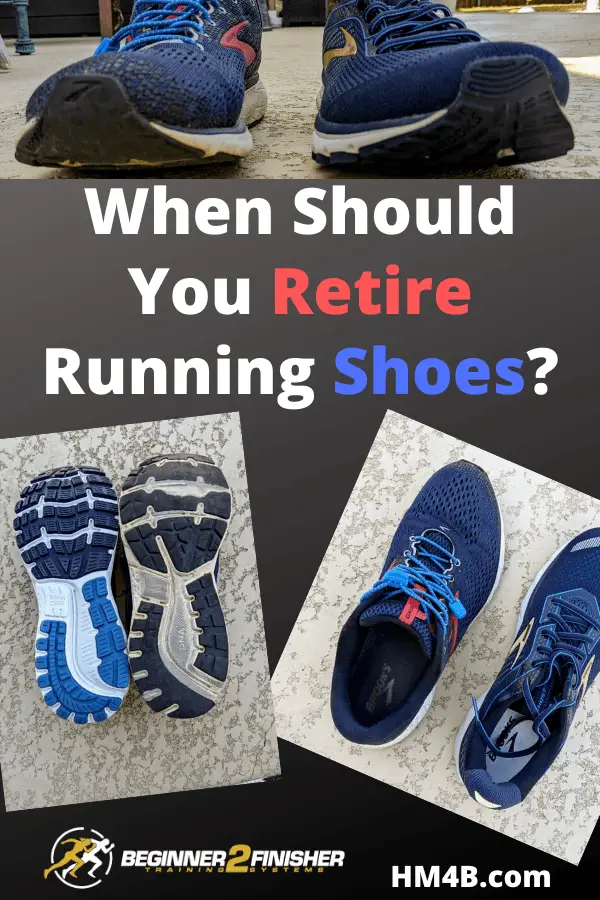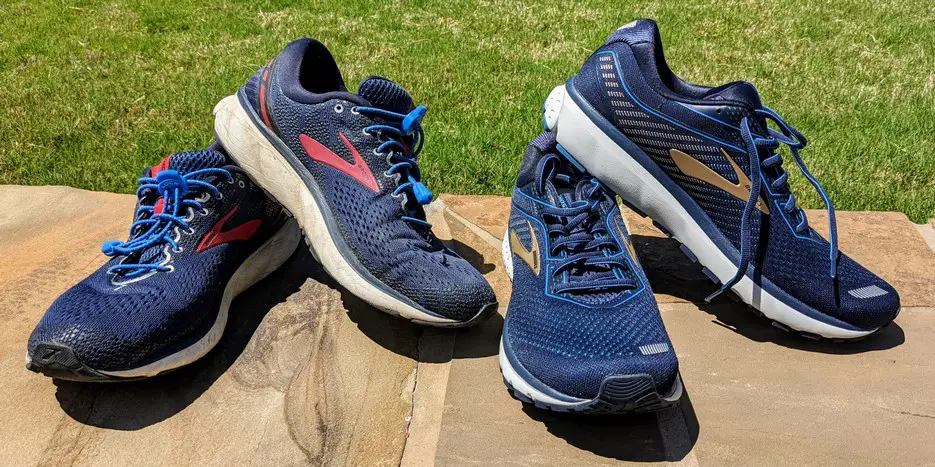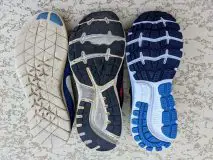If you’ve stuck with running consistently over a year’s worth of time, you’ve probably packed on some miles. If you run roughly 10 miles a week then this would translate into about 40 miles per month.
If you calculate this out, you’re looking at about 520 miles in one year. When you start to stack up the mileage on your running shoes, it’s time to consider replacing your running shoes.
So when should you retire your running shoes?
The golden rule is to retire running shoes somewhere between 300 and 400 miles. However, this isn’t always the case, just a guideline.
For a more accurate way of determining when to retire your running shoes, you need to use your weight in pounds or kilograms. According to OrthoInfo, the more you weigh the more friction will play a roll on wear and tear of your shoes upon ground surface impact.
This puzzled me for quite sometime before I ran across the information presented on OrthoInfo. I’m a 6 foot 3-inch tall runner that purchased a pair of Nike Free RNs. I ran across a friend of mine who was 5 foot 2 inches tall and weighed almost 100 pounds lighter than me. He wore the same shoe as me and told me that his shoes lasted almost 600 miles. My shoes, on the other hand, didn’t last more than about 400 miles until they were toast. Your weight truly does make a difference in how fast your shoe wears down, especially during impact sports such as running.
Check the table below using your weight in pounds or kilograms to determine the mileage of when you should retire your running shoes:
When to retire running shoes based on your weight
| pounds | kilograms | mileage |
|---|---|---|
| 125 | 57 | 600 |
| 130 | 59 | 577 |
| 135 | 61 | 556 |
| 140 | 64 | 536 |
| 145 | 66 | 517 |
| 150 | 68 | 500 |
| 155 | 70 | 484 |
| 160 | 73 | 469 |
| 165 | 75 | 455 |
| 170 | 77 | 441 |
| 175 | 79 | 429 |
| 180 | 82 | 417 |
| 185 | 84 | 405 |
| 190 | 86 | 395 |
| 195 | 88 | 385 |
| 200 | 91 | 375 |
| 205 | 93 | 366 |
| 210 | 95 | 357 |
| 215 | 98 | 349 |
| 220 | 100 | 341 |
| 225 | 102 | 333 |
| 230 | 104 | 326 |
| 235 | 107 | 319 |
| 240 | 109 | 313 |
| 245 | 111 | 306 |
| 250 | 113 | 300 |
| 255 | 116 | 294 |
| 260 | 118 | 288 |
| 265 | 120 | 283 |
| 270 | 122 | 278 |
| 275 | 125 | 273 |
| 280 | 127 | 268 |
| 285 | 129 | 263 |
| 290 | 132 | 259 |
| 295 | 134 | 254 |
| 305 | 138 | 246 |
| 310 | 141 | 242 |
| 315 | 143 | 238 |
| 320 | 145 | 234 |
| 325 | 147 | 231 |
| 330 | 150 | 227 |
| 335 | 152 | 224 |
| 340 | 154 | 221 |
| 345 | 156 | 217 |
| 350 | 159 | 214 |
| 355 | 161 | 211 |
| 360 | 163 | 208 |
| 365 | 166 | 205 |
| 370 | 168 | 203 |
| 375 | 170 | 200 |
| 380 | 172 | 197 |
| 385 | 175 | 195 |
| 390 | 177 | 192 |
| 395 | 179 | 190 |
| 400 | 181 | 188 |
Tracking Your Shoe Mileage
The easiest way to know when it’s about time to retire your shoes is to track your mileage. The Garmin Connect app allows you to enter your running gear and use it for specifically logged activities such as running. Two ways you can track the mileage of your shoes are:
- Garmin Connect

Garmin Connect App – Gear Tracker - Write down the day you bought your shoes and try to track your weekly mileage. Write it down in a journal, calendar, or use an app like Google Keep or Evernote.
What if I haven’t been tracking my shoe mileage?
If you didn’t accurately track your shoe mileage, and most new runners don’t, there are several other ways to tell if you need new running shoes. Here are several things to physically look out for when determining if it’s time to retire your running shoes:
Holes in your tread or shoes
This is one of the easiest things to spot – a hole in your shoe. You’ll definitely need to replace your running shoes ASAP.
Your tread is almost gone
When you first buy your shoes it’s a good idea to take a picture of the bottom of your shoe. When you want to know what exact tread has been eroded, for example after 300 miles, you simply take a picture of your current running shoe and compare it to when it was a new shoe. If you see major wear patterns on several spots on the shoe, it’s probably time to go ahead and purchase some new running shoes.
 Shock Absorption is gone
Shock Absorption is gone
Pay close attention to your impact. If you start feeling pain with every stride it’s time to consider a new pair of running shoes.
Going on the feeling alone
Advantages
- You might be able to conserve your shoes a little bit longer
- You’re spending less money
Disadvantages
- If you wait too long to retire your shoes it’s possible that you could start running differently because the feel of your shoe is less cushiony causing you to compensate in ways that aren’t naturally aligned with your running gait.
Your shoes start feeling too loose
Right when your shoe starts to feel comfortable – it’s almost time to retire the shoe. First of all your shoes should NEVER hurt your feet when you run in them. You might get a slight “wearing in” feeling when your shoes are brand new and they feel a little stiff.
The comfort of the shoe always throws me off that’s why I track the mileage of my running shoes. About 50 miles before retirement of a particular pair of shoes, I go ahead and purchase my new shoes to slowly start to wear them in while slowly phasing out my older shoes. A great place to purchase your shoes is Road Runner Sports where I purchase all of my shoes. They have a great return policy!

Your shoes twist way too easily
If you can physically twist your new shoe with little or no effort, the integrity of your shoe is out the window. When you purchase your new pair of shoes try to twist the shoe. You will immediately tell the difference and see that new shoes are much harder to twist out of their formed shape.
When you run it’s painful
If the pain is on both sides it could be an indication that your cushion is gone and it’s time to retire your shoes. Anytime you feel pain when running you need to stop and assess what’s going on. Catching running injuries early or shoe issues will help prevent longer-term running injuries from being sustained.
They no longer sit in the factory conditioned state.
In other words, they sag or droop to one side or the other and no longer sit upright and stiff. Also, look to see if your shoe can lie flat on the ground if it can’t the shoe needs to be replaced.

Where you run makes a difference
The treadmill is going to cause the tread of your running shoe to wear the least. The grass will come next close behind the treadmill. The track will follow grass in its tendency to wear your shoes tread down.
Trail running sits in the middle of the treadwear scale. Trails, in particular, can be rough on your tread wear as well, however, if you’re running technical terrain (rocks, tree roots, steep inclines) then you should have a second pair of trail running shoes. This will spare your road running shoes taxing tread.
If your trail running is mostly flat and lacks obstacles then your road running shoes should be just fine. For more about trail running check out – Trail Running for beginners – 8 things to know before you go!
The two surfaces that are the roughest on your shoe’s tread are asphalt and then concrete being the tread eating monster.
So if you’re wanting to save some extra tread by only running on a treadmill just remember that if you’re training for a race you need to run about 60% of your runs on the same surface as your actual race. This leads you with two options you need to do most of your running on the trail or on the road.
The only deviation from this is when you’re running a virtual race. In this case, you can run on a treadmill because you can also run your virtual race on a treadmill.
Related: What Is the Most Ethical Running Shoe That Is Best For the Environment?
Not all shoes are the same
If you look at the image below you can see that both shoes have tread loss signaling the need to replace the shoes.
The picture on the left is from my Nike Free RN 2017s. The shoe in the middle is from my Brooks Ghost 11 2019s. The Nike shoes had 412 miles on them when I retired the shoes. My Ghosts had 625 miles on them when I retired the shoes. I got an extra 200 miles out of my Brooks shoes.

How to care for your shoes
- Do not dry your shoes in a tumble dryer
- Instead air dry them. If you need them dried faster try placing a small portable fan facing them.
- Don’t wear your shoes for anything but running. I’m guilty of this one for my first pair of good running shoes. The next pair of running shoes I purchased I took them off as soon as I completed my run.
- Lysol your shoes out after your runs. The Lysol will kill any bacteria in the shoes.
- When your shoes get wet air dry them or sit them in front of a fan. Once they’re dry its time to Lysol them out as well
Other useful tips about running shoes
- Don’t ever run a race in brand new shoes. Your shoes need at least 30+ miles logged on them before racing. The longer the race the more miles that should be logged on your new shoes prior to racing.
You might consider purchasing two pairs of shoes at the same time
Some runners believe that if you have two pairs of running shoes and you alternate between the two shoes, your body doesn’t get used to just one type of shoe. Also, the second pair of a different type of running shoe might also help your leg’s neuromuscular tissues because the two different types of shoes won’t work your legs muscles exactly the same way.

| Help support me and subscribe to my YouTube channel. YouTube video - 30 ways to make your runs less painful! Coach Scott's Credentials:
|
To sign up for a FREE half marathon training schedule, log sheet, and pace predictor CLICK HERE.

Recommended gear for runners
Connect with me:
| facebook.com/BeginnerToFinisher/ |

11 thoughts on “When Should You Retire Running Shoes?”